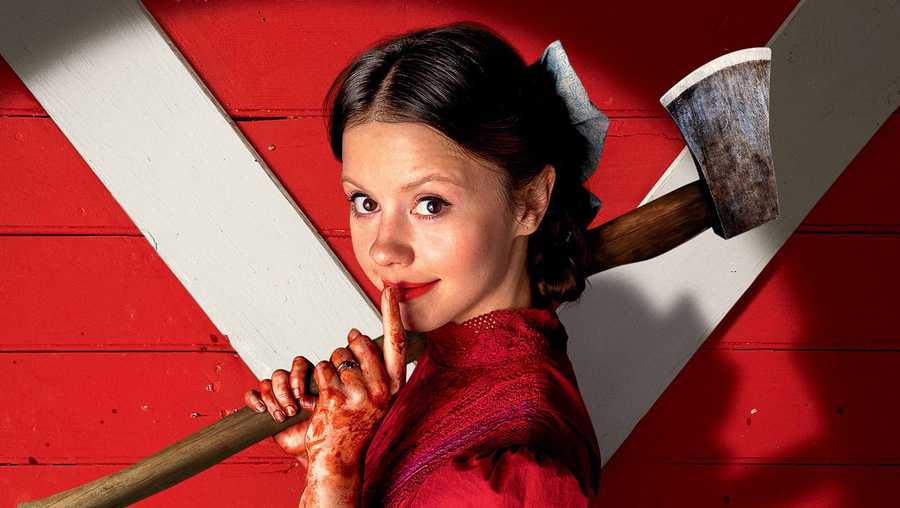
After two long months of waiting following the initial theatrical release of “Pearl”, I finally had a chance to watch Ti West’s modern masterpiece – a film certain to become a cult classic among horror fans.
The film stars the unconventionally sexy Mia Goth, who portrayed both Maxine and Pearl in the first film of the series, “X”, also written and directed by Ti West (although Mia Goth helped to pen the script of “Pearl”).
The film opens with a simplistic, yet extravagant film score, reminiscent of Victor Fleming’s “Gone with the Wind”, as a montage which showcases the homestead and farmyard used as a central set location within the film comes into view. The film score itself was likely pleasant and welcoming by design, as a way to supply the audience with a false sense of security before the carpet is pulled right out from under them. The film’s opening will immediately bring back visuals of “X”, since both films share a central set location. The notable difference, the grainy film stock, evident in “X” is replaced with vibrant colors within the entirety of “Pearl”. As a whole, Ti West did a spectacular job through the utilization of color throughout the film, which reminded me of Wes Anderson’s films – a director known to use rich colors, which propel his audience into a world reminiscent of a living painting by an artist such as Vincent Van Gogh.
Although I can’t speak for the filmmaker, Ti West’s artistic reasoning behind the use of grainy film stock in “X”, contrary to deep, rich colors in “Pearl” may have been done to remind the audience that the films exist within entirely different planes. With “X” being set in the seventies, the throwback would be to low budget slasher films, notably, “The Texas Chainsaw Massacre”, which seems to have been of particular influence to Ti, as well as the B Films of the era. With “X” also being centered around the porn industry of the seventies, the grainy film stock subconsciously supplied the audience with a dirty, cheap feeling, as though they were watching a pornographic film from the seventies such as the notorious “Deep Throat”. “Pearl”, on the other hand, which is set in 1918, nearing the end of World War I, preserves an innocent quality, where the preservation of sexual suppression is clearly evident throughout.
A primary theme of “Pearl” is suppression. Not merely showcased through Pearl’s suppressed sexual desires, but also the suppression she holds in terms of her psychopathic nature, which she has mostly been able to contain when we as an audience are initially introduced to her. The common psychopathic red-flags are all showcased, from Pearl murdering small animals around the farmyard, as well as her physically harming and psychologically tormenting her defenseless, paralyzed father. She does so while subtly hinting that a major mental break within her character is just over the horizon, propelling a potentially redeemable character to the point of no return.
The film also examines the detrimental aspect related to obsessing over fame, which indirectly exemplifies a layer of social commentary to the glaring narcissism of common day society, where millions of young people using TikTok and various forms of social media go to extremes to reach fame. This may not have been Ti West’s intent as a filmmaker, but through Pearl’s consistent desire to obtain fame, the film showcases her own inherent narcissism, while relating to the corrupt and fractured world of today.
It should also be noted that Pearl is not a scary film, but rather a deeply psychological film with disturbing imagery. Where “X” featured multiple jump scares and death’s which occurred mostly at night, nearly all of the murders which occur in “Pearl” happen during the day. What this does is create a further sense of unease due to our expectations as an audience once again being stripped, since the typical horror movie tropes don’t exist. The film score is also anything but predictable, with certain music deliberately going against our expectations for what we would expect to hear in the film. In a scene where Pearl dances with a scarecrow before having simulated sex with it, showcasing a delusional, child-like aspect of Pearl’s personality, we hear an upbeat, lively song which contradicts the overall mood.
The film also examines Pearl’s complicated relationship with her mother, Ruth, played by the talented Tandi Wright, a New Zealand actress whose work is likely unfamiliar to most mainstream, North American audiences. The relationship itself is one of control, where Ruth serves as a domineering force of nature, who seems to be the only person in the film Pearl seems too genuinely be afraid of. Even following a heated kitchen scene which leaves Ruth suffering from severe burns and incapacitated, Pearl’s unrelenting fear of her mother is showcased further through daydreams experienced by Pearl. Still, despite how evil Pearl undoubtedly is, a love for both of her parents is clearly evident, indicating that even the most cruel of hearts are still capable of some level of compassion.
The film as a whole is a complicated, exceptional feat in filmmaking. Ti West did a brilliant job of incapsulating the era showcased, with exceptional performances from the entire cast, particularly Mia Goth through her performance as Pearl. A performance which will not be on the radar of most critics during Awards Season, but perhaps it should be, due to being as nuanced and demanding a role as Evan Peters layered performance as Jeffery Dahmer in the controversial Monster series on Netflix, a role which is likely to receive several nominations for the actor. Also, if even Martin Scorsese, one of the most important filmmakers of our generation, was left feeling deeply disturbed and unable to fall asleep after viewing "Pearl”, while praising Mia Goth’s performance, I believe that is all the more reason to give Mia Goth the attention and glory that her performance deserves.
Although I have left out a majority of the plot, as to not ruin the film for anyone who has yet to give it a view, I will mention that the ending was one of the most disturbing to any film I have viewed in recent years. An ending which parallels the dining room scene within the original “Texas Chainsaw Massacre”, through Ti West’s choice to use imagery to provoke reaction, rather than cheap thrills through modern horror films which forget the basis of film – to challenge the viewer, rather than bore them through predictability.















